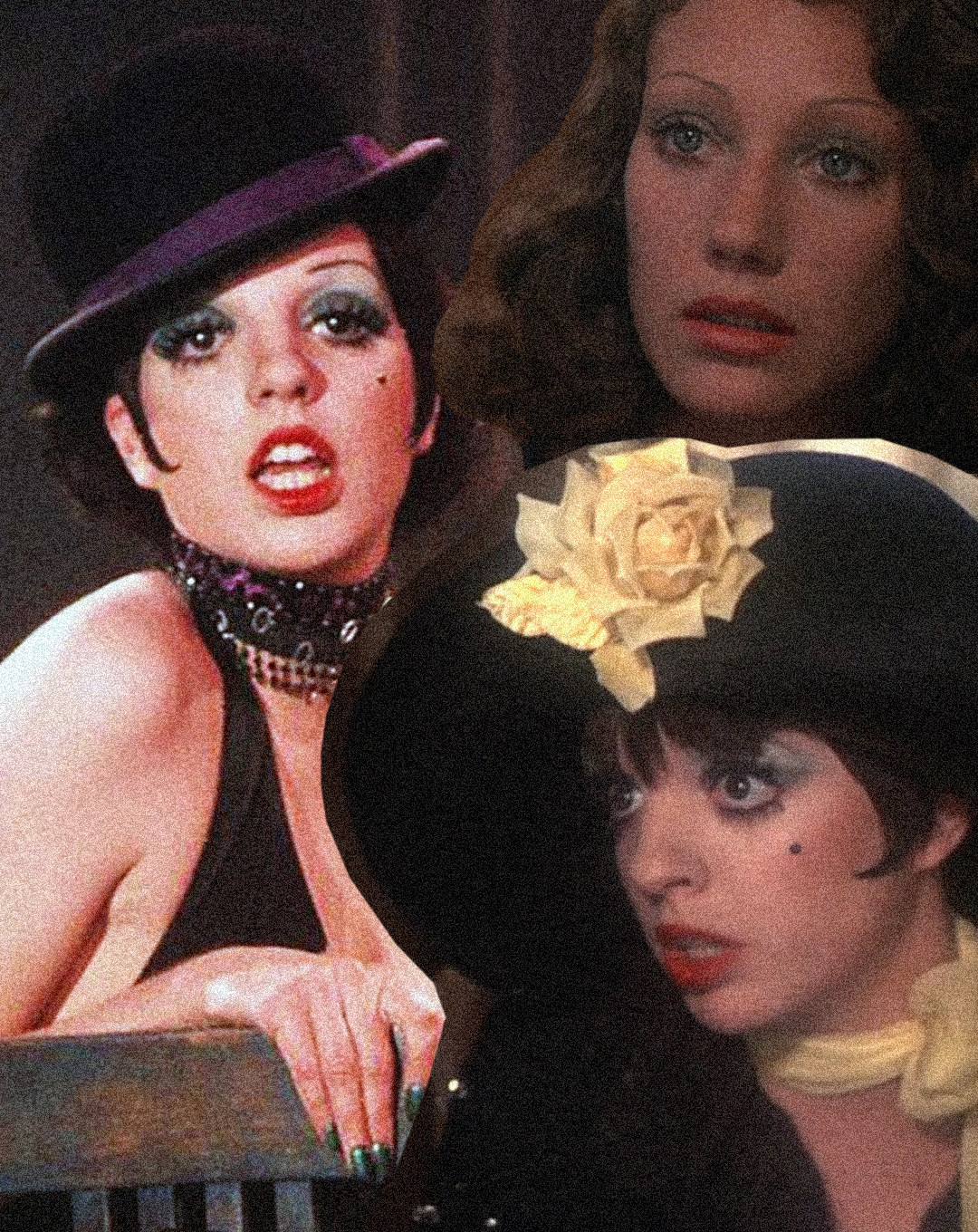Beauty Archivist: Cabaret’s Makeup is an Argument Against Winged Eyeliner
The face of Sally Bowles is lit against a black empty screen. Her eyes are watery and wide open. The whites visible all the way around her iris. The sequin she uses as a beauty spot hits the light, as does the wetness of her eyes. Brian Roberts’ face is healthy, tanned but covered in a film of sheeny sweat. The Emcee’s heavy white grease paint is dry at the forehead, exaggerating the contortions of his face, which breaks into sweaty heat as he starts to dance with the chorus. Saliva flashes on his teeth as he sings. The beauty in Bob Fosse’s Cabaret is wet. Everyone is sweating. Thick stage makeup is disintegrating under lights. Liza Minelli, as Sally, wears her eyelashes in heavy clumps that point directly up to reach her brow and down to skim her cheekbone. You can see the powder on her skin, there’s visible texture.
Watching the characters sweat through Cabaret made me realise how unusual a visual this is on film. Especially when you think of the uncannily perfect, blow dried actors racing through action sequences, typical of contemporary films. 1972’s Cabaret in contrast feels grimy. The presence of perspiration, spit and watery eyes lends a grotesque visceral quality to its characters. I have seen the movie twice, the first time around 11 or 12 and then again this summer. The first time I was mostly just fascinated by how glamorous Bowles was, but also felt some element of thrilled repulsion. Watching it as an adult I can now see the themes and context I didn't have the maturity to notice or understand the first time. The moral vacuum of its central character as she chooses hedonism and cynicism against a backdrop of rising facsism in the Weimar Republic. Still, I was always tipped off to the darkness in the film without really understanding it by the way it mixes glamour and the grotesque in the faces of its stars. The wet, sweaty, griminess of it all is no small element of that. It is significant that the only dry person in the film is Natalia Landauer, by the end, the only morally uncompromised character.
___STEADY_PAYWALL___
The makeup in Cabaret is lavish but crude. It is a vision of the 30s as filtered through the 70s. On stage Sally’s eye shadow is an opaque block of green tinged blue, her face is powdered pancake porcelain, her red lips are slightly underdrawn and round without crisp edges, her eyebrows are fiercely dark lines that look like they were constructed with a single swipe of a pencil. The lashes are huge spiders, almost as long on the bottom as they are on the top and the same length from inner to outer corner, giving her circular baby doll eyes. Nothing about Sally’s look is precise, it's beautiful but also a bit unsettling. It looks painstakingly but inexpertly applied by someone who puts new eyeliner over the top of last night’s each morning.
Natalia’s makeup is a much more delicate version of the same rounded 30s/70s aesthetic. Her brows are tweezed into a line just as fine as Sally’s, although hers are penciled in a soft taupe. Her lids a soft shimmering but see-through wash of avocado green with heavy mascara top and bottom. The skin looks groomed but also fresh and sheer, you can see freckles, beauty marks and natural variations in skin tones in her complexion, the lip is a blotted coral stain. Circles are the dominant form in all Cabaret’s beauty looks; the heavy featureless base and low blush remove dimension from faces making them flat and round. The lip shapes are squashed circles with a V cut out for the cupid’s bow. Brows are U-shaped. The total opposite of the winged up and out diagonal lines that are synonymous with beauty today.
Seeing beauty dominated by a different structure to “normal” highlights just how much we can distort our expression when we create direction and form in the planes of the face. It's so easy to start to see dominant aesthetics as neutral, so reminding yourself of what the opposite looks like is a great refresh on just how much we influence our faces by things as simple as an elongated eyeliner, a tweezed brow and a contour.
We all instinctively understand how important eyebrows are for communication and broadcasting our emotions. When we influence their shape we are nudging the expression towards a different neutral. It is interesting to think that what is considered beautiful in different decades also has a relationship with how our expression is read and therefore what sort of person we might be. The completely round, very high and archless eyebrows in Cabaret create an ideal beauty that feels like it has a different personality to the straight lifted eyebrows of today’s fox-eye aesthetic.
To me the circular lines of Cabaret’s faces create a sweet open fullness, the brows are subtly surprised, and suggestive of naivety and youthfulness. On the faces of the chorus and the Emcee this combination of the exaggerated roundness, the heavy thick texture, the coarse application, garish colour and then the beading of sweat starts to feel extremely sinister. It also adds to the chameleon quality of Sally and our constantly shifting emotions towards her. In the scenes at her apartment, without her full Kit Kat Club face on, the wide-eyed almost childlike appearance of her face can make her seem intensely vulnerable. As the film progresses you wonder if in fact it was the vulnerability that was the illusion.
Words: Grace Ellington


